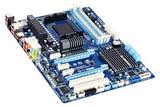Dnetc@Home project have been closed.
Read more from
Dnetc@home website
Don't worry there is another project running with same goals as Dnetc@home.
Project is
Moo!Wrapper . Same
applications for same hardware(gpus,cpus) with Dnetc@home and same points.
There's always
Milkyway@Home for AMD 48xx,58xx,69xx series gpus.
For Nvidia gpus
GpuGrid and
Primegrid.
Milkyway@Home uses the BOINC platform to harness volunteered computing resources, creating a highly accurate three dimensional model of the Milky Way galaxy using data gathered by the
Sloan Digital Sky Survey. This project enables research in both astroinformatics and computer science.
 GpuGrid
GpuGrid : is a novel distributed supercomputing infrastructure made of many
NVIDIA graphics cards joined together to deliver high-performance all-atom biomolecular simulations.Running GPUGRID on GPUs innovates volunteer computing by delivering supercomputing class applications on a cost effective infrastructure which will greatly impact the way biomedical research is performed.
PrimeGrid :
PrimeGrid's primary goal is to bring the excitement of prime finding to the "everyday" computer user. By simply
downloading and installing BOINC and attaching to the PrimeGrid project, participants can choose from a variety of prime forms to search. With a little patience, you may find a large or even record breaking prime and enter into Chris Caldwell's
The Largest Known Primes Database as a
Titan!
PrimeGrid's secondary goal is to provide relevant educational materials about primes. Additionally, we wish to contribute to the field of mathematics.
Lastly, primes play a central role in the cryptographic systems which are used for computer security. Through the study of prime numbers it can be shown how much processing is required to crack an encryption code and thus to determine whether current security schemes are sufficiently secure.
 We will release a new client by the end of next week. This client will be incompatible with the current client. Therefore we will starve the server of workunits the next week. Starting Monday no new workunits will be generated. We will then take the server offline on Friday to do a server upgrade to enable GPU client compatibility. This release will still be without GPU support. We expect the GPU support to be ready hopefully one week after.
We will release a new client by the end of next week. This client will be incompatible with the current client. Therefore we will starve the server of workunits the next week. Starting Monday no new workunits will be generated. We will then take the server offline on Friday to do a server upgrade to enable GPU client compatibility. This release will still be without GPU support. We expect the GPU support to be ready hopefully one week after.









